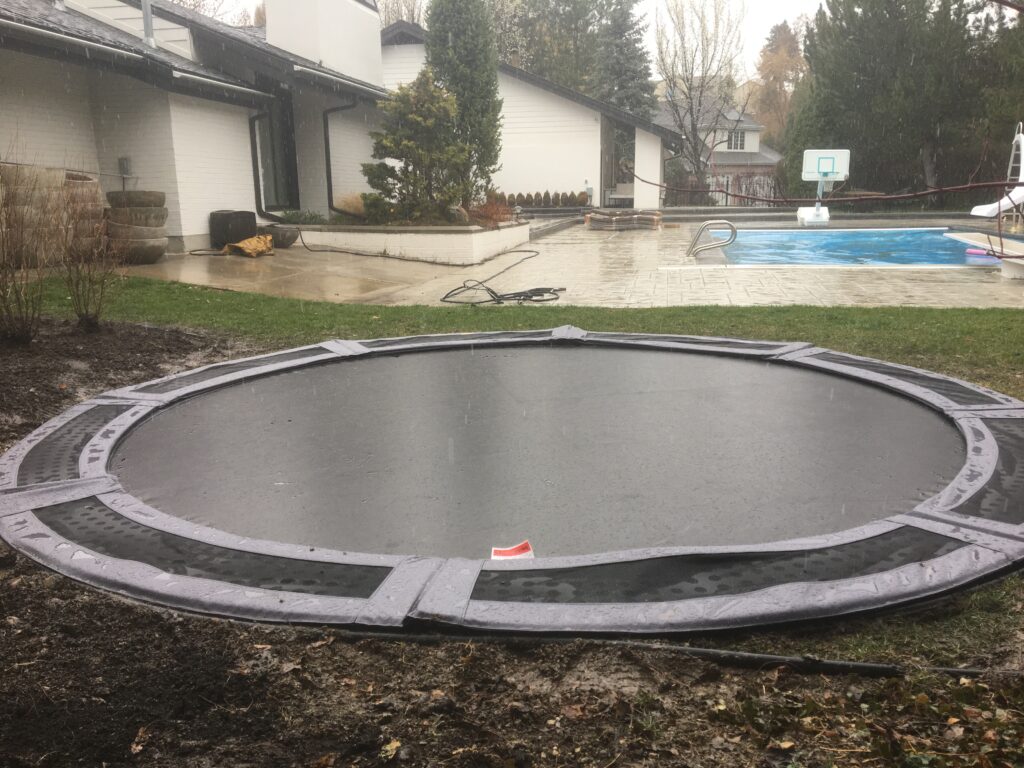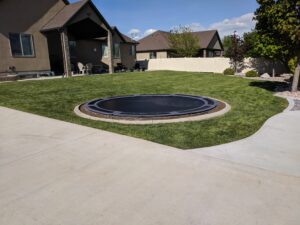A sunken trampoline, also known as a buried or in ground trampoline also needs a retaining wall. This is to stop soil falling back into the excavated pit and allows easy access for landscaping around the trampoline. Trampoline retaining walls are available as kits, bundled in with the trampoline frame, or you can even try constructing your own.
The Parts of an In-Ground Trampoline
If you’re buying a trampoline from scratch, it will come with several parts. These are often available together as a kit, although sometimes you might choose to buy them separately.
The main parts of an in-ground trampoline are:
The trampoline frame, mat and springs
An in-ground trampoline can be round, square or rectangular, whatever best suits the available area and the owner’s taste. The mat can also be a variety of sizes, the most popular being up to 14 feet in diameter for a round trampoline and up to 14 feet by 10 feet for a rectangular model. The mat is attached to a frame with metal springs. For a long-lasting trampoline experience, the frame and springs should ideally be galvanized steel to prevent rusting.
The trampoline retaining wall
There are in-ground trampoline kits available with everything you need including the retaining wall. These can be panels of plastic or metal that attach to the trampoline frame and stop soil and debris from falling back into the trampoline pit. They also reinforce the area surrounding the trampoline mat so you can walk and mow right up to the edge of your sunken trampoline. You can also buy separate retaining wall kits or systems that can attach onto your existing trampoline.
Vented pads
Pads are necessary for several reasons: to allow air flow around your in-ground trampoline which helps with bounce height, to provide some cushioning in case of a fall, to add extra coverage of the springs to avoid injury and to complete the look of your sunken trampoline.
Accessories
Once you’ve decided on a kit for your in-ground trampoline, you can also add some extras. Safety netting can be erected around the trampoline to provide peace of mind for those families with younger jumpers. Covers can also be purchased to protect the bouncing surface from harmful UV rays, heavy snowfall and debris that can damage the mat or somebody using it.
Do I Need a Trampoline Retaining Wall Kit?
It may seem like an unnecessary step but if you’re installing an in-ground trampoline, a retaining wall is definitely needed. Without a retaining wall, the surrounding dirt and soil could collapse back into the excavated pit, destroying the look of your landscaping and reducing the bounce height. If stones and other debris fall into the space under the trampoline mat, this could cause damage to both the mat surface and the jumper above.
In-ground trampoline retaining wall kits have all the panels and parts you need to safely install your trampoline. Most kits will attach directly to your trampoline’s frame on the outside of the legs. You can either buy a separate retaining wall kit or purchase one as part of a set with the trampoline and pads.
Here are the main reasons for purchasing a retaining wall kit for your sunken trampoline:
- To keep soil from falling back into the trampoline pit, ensuring a secure and effective bouncing experience
- To enable landscaping and garden maintenance right up to the edge of the in-ground trampoline
- To keep trampolines in place
- To help level out the ground if it’s an uneven surface
Trampoline retaining wall kits are the best and easiest way to get the most out of your new in-ground trampoline.


